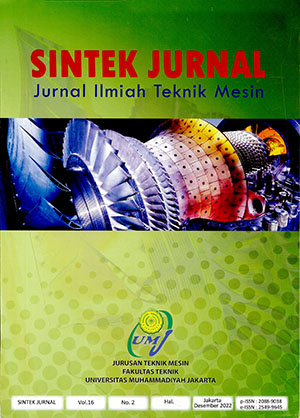Unjuk kerja catalytic converter katalis tembaga krom terhadap penurunan temperatur emisi bas buang motor bensin
Main Article Content
Abstract
Article Details
- Articles published in SINTEK JURNAL are licensed under a Creative Commons Attribution-ShareAlike 4.0 International license. You are free to copy, transform, or redistribute articles for any lawful purpose in any medium, provided you give appropriate credit to the original author(s) and SINTEK JURNAL, link to the license, indicate if changes were made, and redistribute any derivative work under the same license.
- Copyright on articles is retained by the respective author(s), without restrictions. A non-exclusive license is granted to SINTEK JURNAL to publish the article and identify itself as its original publisher, along with the commercial right to include the article in a hardcopy issue for sale to libraries and individuals.
- By publishing in SINTEK JURNAL, authors grant any third party the right to use their article to the extent provided by the Creative Commons Attribution-ShareAlike 4.0 International license.
References
Springer - Verlag New York Inc, 1970, Catalyst Hanbook. Walfe Scintific Book, London - England.
Dowden , at all, 1970, Catalytic Hand Book, Verlag New York, Inc.
Irawan, 2004, Rancang Bangun Catalytric Converter dengan Material Substrat Tembaga (Cu) untuk Mereduksi Emisi Gas CO, Jurnal Traksi.
Warju, 2006, Pengaruh Penggunaan catalytic Converter Tembaga berlapis Mangan Terhadap Kadar Polutan Motor Bensin Empat langkah. Institut Teknologi Surabaya.
Obert, 1973, Internal Combustion Engine and Air Pollution, Third Edition. Harper & Row, Publisher, Inc, New York.
LIyod , 2011 , Handbook of Industrial Catalysts, Fundamental and Applied Catalysis.
Mattey, 2014, Dennis Dowden and the Development of Catalytic Science, Technology Review, www.technology.mattey.com.
Irawan, B., 2007, Pengaruh Letak Pemasangan Catalytic Converter Terhadap Keluaran Emisi Gas Carbon Monoksida dan Hidro Carbon Motor Bensin, Majalah Traksi.
Heisler, H., 1995,Advanced Engine Tecnology Hodder Headline Group,London.
Heywood, John B,1988,Internal Combustion Engine Fundamentals. International Edition. Graw-Hill, Inc., New York.
Irawan B., 2021, Pengaruh Perubahan Putaran Mesin Terhadap Temperatur Catalytic Converter Berbahan Logam Transisi Tembaga Mangan.
Irawan B., 2021, Effect Of Number Of Transition Metal Catalyst Cell Manganese Catalytic Converter On Exhaust Basis Emission Output Carbon Monoxide Motor Gasoline, Sintek Jurnal.


